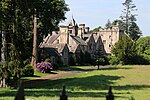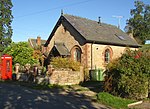Temple Sowerby railway station
1862 establishments in England1953 disestablishments in EnglandDisused railway stations in CumbriaFormer North Eastern Railway (UK) stationsNorth West England railway station stubs ... and 3 more
Railway stations in Great Britain closed in 1953Railway stations in Great Britain opened in 1862Use British English from October 2017
Temple Sowerby railway station was a railway station situated on the Eden Valley Railway between Penrith and Kirkby Stephen East. It served the village of Temple Sowerby. The station opened to passenger traffic on 9 June 1862, and closed on 7 December 1953. It is now a private residence.
Excerpt from the Wikipedia article Temple Sowerby railway station (License: CC BY-SA 3.0, Authors).Temple Sowerby railway station
A66,
Geographical coordinates (GPS) Address External links Nearby Places Show on map
Geographical coordinates (GPS)
| Latitude | Longitude |
|---|---|
| N 54.6276 ° | E -2.6006 ° |
Address
Temple Sowerby
A66
CA10 1RA , Temple Sowerby
England, United Kingdom
Open on Google Maps









